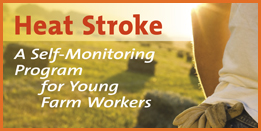Training Room 1: First Steps to Safety—Understanding Hazards
Promoting Farm Safety
Session 6: Identifying Agricultural Hazards—Farm Environmental Hazards
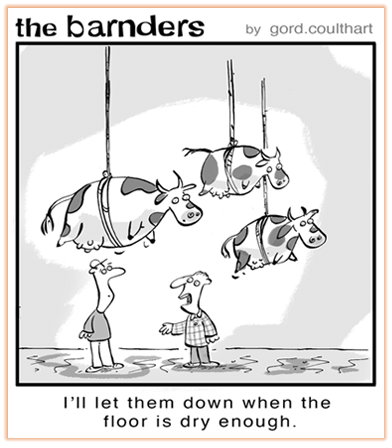
Courtesy of Gordon Coulthart and The Canadian Agricultural Safety Association
Farm workers must be aware of a wide range of environmental hazards that are potentially harmful to their health and well-being. Environmental hazards on a farm include water hazards, excessive noise exposure, sun exposure and heat-related illnesses, air-borne particles, fuel and other toxic pollutants.
Learning Target
In this session you will learn to identify some environmental hazards common to many agricultural settings. Consider the following question as you go through this session:
- What can I do to prevent injury from the environmental hazards in my workplace?
Identifying Environmental Hazards
There are hazards that you encounter in your agricultural environment on a daily basis that can cause short-term injury or long-term illness. Awareness and assessment of the hazards you work with are the first steps to keeping workers healthy and safe.
Click each of the tabs below to explore the various environmental hazards on an agricultural worksite.
-
Noise
-
Sun
-
Heat
-
Water
-
Human Factors
Noise Exposure Hazards
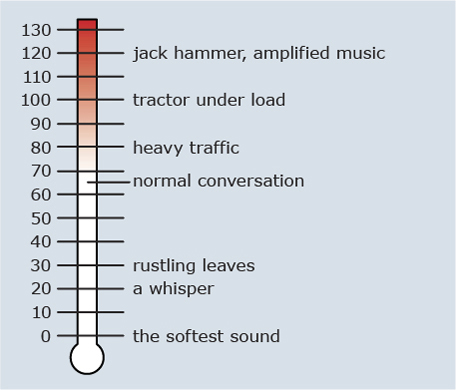
Alberta Farm Safety. Used with permission.
"Did you know? A squealing pig can hit 130 decibels. This is louder than thousands of cheering fans and screaming guitars at a hard rock concert!"
From Alberta Agriculture and Rural Development. Safety Up—On Hearing.
Prolonged exposure to excessive noise levels may result in nerve damage and possibly permanent hearing loss. Noise can also lead to fatigue and reduced work output. Hearing loss accumulates over time and can be caused by noise emitted from such things as tractors, grain dryers, power tools and squealing pigs.
Decibel Scale—Strength of Sound Vibrations from Safety Up—On Hearing.
To Do
- Read more about the hazards of farm noise in the Safety Up—On Hearing article from the Alberta Department of Agriculture and Rural Development.
- Find out what to do to protect your hearing on the Youth in Agriculture website from the US Department of Labor.
- Test how clearly you can hear in different levels of background noise by trying this hearing test at www.hear-it.org.
Sunshine: A Hazard?
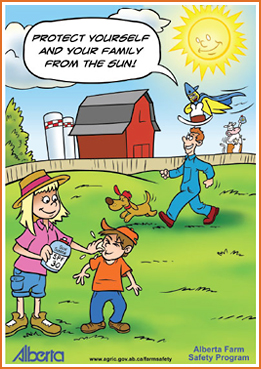
Alberta Farm Safety. Used with permission.
The sun can be a hazard to farmworkers who are often outside and exposed to the sun's radiation for long periods of time. Sunlight can cause damage to skin and eyes through long term exposure to ultraviolet rays. Taking precautions against health risks from this hazard is important.
To Do
This Powerpoint, Sun Safety, will help you understand the hazards and health issues caused when you are not careful to control this hazard.
Powerpoint from Canadian Center for Health and Safety in Agriculture - University of Saskatchewan
Image from Farm Safety Posters: Protective Gear - Government of AB: Dept. of Agriculture and Rural Development
Heat Stress
High temperatures, high humidity, sunlight, and heavy workloads increase the likelihood of heat stress for farm workers.
To Do
Click on the picture to link to an article. Read up on research looking in to how young farm workers can be exposed to the hazard of heat stress.
Read Safety Up: On Sun Exposure to learn about warning signs of heat stress and things you can do to control this hazard when you work in hot conditions.
Water Hazards
Many areas on a farm can be considered a drowning hazard including large areas such as ponds, sloughs, irrigation ditchs, and even the backyard recreational swimming pool. Even small sources of water such as rain barrels, paddling pools and buckets can be a hazard to small children.
Ensuring that there are effective barriers, signs and supervision of young people is just the beginning. You need to ensure that you have the water safety skills to keep youself safe.

Alberta Farm Safety. Used with permission.
To Do
Read the following fact sheet for more information what you can do to be alert and prepared for water hazards on your work site.
Click on link for an article from Alberta Agriculture and Rural Development's: Safety Up - On Water Hazards.

Gordon Coulthart/Courtesy of Canadian Agricultural Safety Association
Human Factors
Ergonomic factors are factors in which the design and use of equipment in the workspace affects injury. Poor ergonomic design of equipment/space or improper use of equipment can be become a health and safety hazard. These ergonomic hazards could include:
- Use of tools in awkward positions which can lead to musculoskeletal injuries.
- Long periods of standing on concrete floors which can lead to lower back injury, sore legs and hips, varicose veins, and heel spurs.
- Long periods sitting on equipment such as tractors, that have improper seat adjustments. Continuous vibration can lead to shoulder, lower back, spine, hip and leg injury.
- Improper lifting and carrying techniques when moving heavy supplies and equipment which can lead to back and shoulder injuries.
Human factors, such as increased fatigue and stress, are also important hazards that can increase the risk of injury.
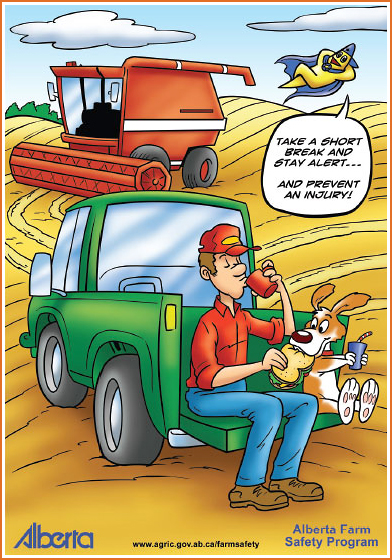
Alberta Farm Safety. Used with permission.
To Do
Watch this video clip from the Canadian Agricultural Safety Association to learn more about ergonomic hazards and how to prevent them. Scroll down the video page and watch Prevention of Musculoskeletal Injuries.
Time to Practise
Your task: Work on your project
Choose one of above the enviromental hazards that you could encounter in your workplace.
-
Determine the type of environmental hazard you have chosen and how this hazard could affect or injure you. (Remember: physical, chemical, biological and psychological.)
-
Create at least five questions/statements/images that would help you identify the different things you need to look for when assessing this environmental hazard in your workplace.
-
Add these statements/questions/images to your Project 1—Health and Safety Assessment Planning Template.
